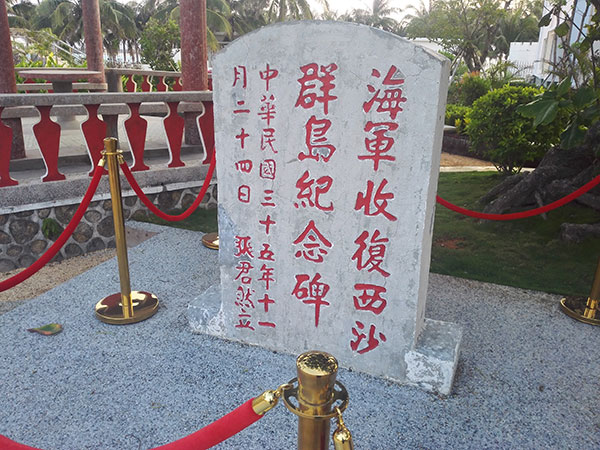Tower, stone witness China's sovereignty
Updated: 2016-05-24 08:18
By Zhang Yunbi(China Daily)
|
|||||||||
 |
|
A 1-meter-tall stone stands on Yongxing Island, marking the return of the island to Chinese sovereignty. ZHANG YUNBI/CHINA DAILY |
 |
|
Reporter's log |
The gun tower, now empty of weapons and refurbished was built by Japanese imperial forces after their occupation began in 1939. Its square openings allowed gun crews to train their fire on the South China Sea.
Both are located on the western part of one of China's Xisha Islands.
The two reminders of history are just a few meters from each other, and easily attract the attention of inquisitive passers-by. The leaves of coconut trees, swaying in the breeze, cast fleeting shadows on them in an almost idyllic scene.
The Xisha and Nansha islands were returned to Chinese sovereignty under the Cairo Declaration and the Potsdam Proclamation, and the Chinese government retook the islands in 1946.
The history of the islands, and their recovery, remind me of Foreign Minister Wang Yi's remarks when he was asked about the South China Sea in June last year at the World Peace Forum in Beijing.
"At that time, China and the US were allies, and Chinese personnel recovered the Nansha Islands from on board US warships. The American friends should be clear about this," Wang said.
Zhang Haiwen, a leading Chinese expert on international maritime law with the State Oceanic Administration, said that one of the most valid measures to confirm China's jurisdiction, in terms of international law, was publicly recovering the Xisha and Nansha islands by dispatching troops and prominent figures there.
To demonstrate China's sovereignty, officials and officers organized celebratory cannon fire and raised flags marking the return of the islands.
"Those measures effectively proved that China regained its sovereignty over the South China Sea islands. Also, the international community did not voice objections to such measures," Zhang said.
In addition to the United States, Japan has increased its profile concerning the South China Sea in the past two years. Tokyo is also seeking to pass a strong declaration on the South China Sea during the upcoming G7 summit in Japan.
There has been a widely accepted definition and agreement about Tokyo's wartime role. This may be ignored or glossed over by some in Japan, but wounds that were then inflicted are still sensitive.
As Japan frequently campaigns for reinforcing military cooperation with countries such as the Philippines, and boosts its military presence in the South China Sea, peace-loving people like to ask: What is Japan's ultimate purpose? Is it benefiting from stirring up the situation here? Are Japanese right-wingers trying to return to their past "glory"? These are questions that should not need to be asked, as the coconut tree leaves cast their shadows over reminders of history.
- China's stance on South China Sea wins more international backing
- South China Sea issue
- Chinese embassy refutes Washington Post editorial on South China Sea
- Divide in South China Sea serious, but under control
- Afghanistan backs Beijing on South China Sea
- Divide in South China Sea serious, but under control
- Wildfires continue to rage in Russia's Far East
- Eiffel Tower to become rental apartment for first time
- US lifts arms embargo on Vietnam
- At least 17 schoolgirls killed in boarding-house fire in N Thailand
- Russia to build first cruise liner in 60 years
- LinkedIn, Airbnb match refugees with jobs, disaster survivors with rooms

 Stars of Lijiang River: Elderly brothers with white beards
Stars of Lijiang River: Elderly brothers with white beards
 Wealthy Chinese children paying money to learn British manners
Wealthy Chinese children paying money to learn British manners
 Military-style wedding: Fighter jets, grooms in dashing uniforms
Military-style wedding: Fighter jets, grooms in dashing uniforms
 Striking photos around the world: May 16 - May 22
Striking photos around the world: May 16 - May 22
 Robots help elderly in nursing home in east China
Robots help elderly in nursing home in east China
 Hanging in the air: Chongqing holds rescue drill
Hanging in the air: Chongqing holds rescue drill
 2.1-ton tofu finishes in two hours in central China
2.1-ton tofu finishes in two hours in central China
 Six things you may not know about Grain Buds
Six things you may not know about Grain Buds
Most Viewed
Editor's Picks

|

|

|

|

|

|
Today's Top News
Liang avoids jail in shooting death
China's finance minister addresses ratings downgrade
Duke alumni visit Chinese Embassy
Marriott unlikely to top Anbang offer for Starwood: Observers
Chinese biopharma debuts on Nasdaq
What ends Jeb Bush's White House hopes
Investigation for Nicolas's campaign
Will US-ASEAN meeting be good for region?
US Weekly

|

|









